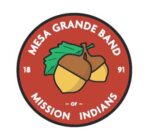PART 1: 1852 to 1905 How the reservations got their shapes
Click to see MAP
This report describes four tracts of land and two Indian bands: Mesa Grande and Santa Ysabel. After review and analysis of extensive documentation produced by the Office of Indian Affairs (OIA) (Cited No. 1), the Bureau of Indian Affairs (BIA), expert historians, local newspapers, and other primary and secondary sources, this report concludes that the evidence demonstrates that the Mesa Grande Band of Mission Indians and the Santa Ysabel Band of Diegueno Indians were separate and distinct bands and resided on separate parcels of land. The Mesa Grande Band occupied the area that included the lands known as Santa Ysabel Tracts Nos. 1 and 2 in addition to the 120 acres set aside for it in 1883 and patented for it in 1893 (also referred herein as the Black Canyon reserve). The Santa Ysabel Band, which became known for a time as the Volcan Band, resided in the village on the Rancho Santa Ysabel and then on the Santa Ysabel Tract No. 3, which became known for a time as the Volcan Reservation. Furthermore the historical evidence clearly demonstrates that Government officials, non Indian residents of the area, and the members of the Bands themselves all understood these facts to be accurate. This report will use the aforementioned documentation to demonstrate these facts.
Due to the lengthy township and range descriptions and the varying usages of the correspondents of the period, this report uses abbreviations for the four land parcels. the tract known as Santa Ysabel Tract No. 1 (Cited No. 2) includes approximately 2,995 acres within Township 12 South, Range 2 East, Sections 3, 10, 13, 14 and 15 in the San Bernardino Meridian. Santa Ysabel Tract No. 2 (Cited No. 3) includes approximately 2,720 acres in Township 11 South, Range 2 East, Sections 21, 25, 26, 27 and 28. Santa Ysabel Tract No. 3 (Cited No. 4) includes approximately 9,282 acres in Townships 11 and 12, Range 3 East, and was also called Volcan and Balcan by correspondents of the day. The 120 acres set aside in 1883 and patented in 1893 in Township 12, Range 2 East, Sections 8 and 9 are referred to as Black Canyon, the term used by present day residents of the area.
(Cited No. 2) (Cited No. 3) – Harwood Hall, Supervisor of Indian Schools, Report on General Inspection Mesa Grande Indian School District, Calif., Section 14 – Land, June 18th 1909, NARA-DC, RG 75, CCF, 1907-39, Mesa Grande Agency, Box 2, File 50326-10-1909-308 (MG-0631) The acreage figures for Tracts Nos. 1 and 2 are from a 1909 report and do not include later adjustments. Furthermore, the figures vary from year to year and source to source. There are no definitive acreage reports for the two Tracts.
(Cited No. 4) – Harwood Hall, Supervisor of Indian Schools, Report on General Inspection Volcan Indian School District, Santa Ysabel Calif. Section 14 – Land, June 24th 1909, NARA-DC, RG 75, CCF, 1907-39, Volcan Agency, Box 2, File 52021-09-342 (MG-0632) The figure for Tract No. 3 is from a 1909 report and does not include subsequent adjustment to the reservation. Furthermore the figures vary from year to year and source to source. There is no definitive acreage report for Tract No. 3.
